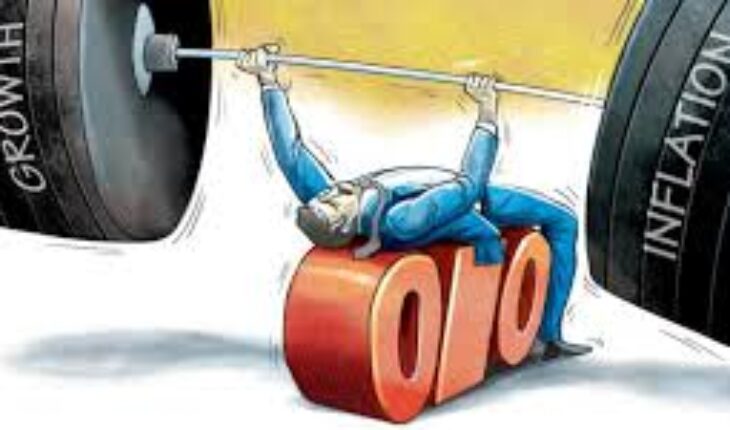Due to no significant decline in the level of inflation, on April 5, the Reserve Bank of India kept the repo rate unchanged at 6.5 percent in the monetary review and did not make any change in other policy rates. With this decision of the central bank, the current pace of development is likely to remain intact and due to this, along with the announcement of the results of the monetary review, a slight increase was also seen in the stock market.
The Reserve Bank has not made any change in the key policy rates for the seventh time. The central bank last raised the repo rate to 6.5 percent in February 2023. There has also been a history of not increasing the repo rate for a long time. During the economic recession of 2008, the repo rate remained at 6.5 percent for 10 months. Even during the debt crisis of 2013, the repo rate remained unchanged at 7.85 percent for 8 months. Then, in 2020, even during the Corona period, the repo rate remained at 4 percent for 25 months.
The Reserve Bank tries to fight inflation by increasing the repo rate. When the repo rate is high, banks get loans from the Reserve Bank at a higher rate, due to which banks also give loans to customers at a higher rate. By doing this, the liquidity of money in the economy decreases and due to lack of money in the pockets of the people, the demand for goods reduces and owing to the high price of goods and products, their sale declines, on account to which a waning in inflation is recorded. Similarly, when there is a slowdown in the economy, an attempt is made to increase the liquidity of money in the market to accelerate the developmental work and for this also the repo rate is cut, so that banks get loans from the Reserve Bank at a cheaper rate and after getting loans at a inexpensive rate, the bank also gives loans to the customers at a lower rate.
The main reason for not changing the repo rate and other policy rates is inflation. The Ministry of Statistics and Program Implementation released the latest inflation data based on the Consumer Price Index (CPI) on March 12, 2024, according to which retail inflation declined marginally to 5.09 percent in February 2024, which is the lowest level in the last 4 months. Retail inflation was at 5.10 percent in January 2024, while it was at 5.69 percent in December 2023. It is within the tolerance limit set by the Reserve Bank of India, which is 2 percent more or 2 percent less than 4 percent. Despite this, this rate cannot be considered encouraging for rapid growth.
Inflation plays an important role in determining one’s purchasing power. When inflation increases, the prices of both goods and services upsurge, which reduces the purchasing power of the person and the demand for goods and services decreases. Then, their sales decline, their production shrinkages, the company suffers losses, workers are laid off, employment generation falls, etc. As a result, economic activities slow down, and the pace of development is hampered.
Inflation rate is still very high in most countries of the world, while the level of inflation has decreased in some countries, the main reason for which is the diminution in the price of crude oil in the international market and the reduction in the obstacles in the way of supply chain.
Along with the latest data of World of Statistics, inflation in some countries of the world ranges from 100 percent to 250 percent. Argentina is the most expensive country in the world, where the inflation rate is 254 percent. Lebanon is at second place, while Venezuela is at third place. Pakistan is among the top 10 countries of the world with an inflation rate of 28.3 percent, while the inflation rate in Bangladesh is 9.86 percent.
However, inflation is decreasing in developed countries. Inflation rate in England is 4.0 percent, while in USA it is 3.1 percent. Inflation rate is also 3.1 percent in France and this rate is 2.6 percent in Japan. At the same time, Thailand has the lowest inflation rate in the world at minus 1.11 percent, while the inflation rate in China is minus 0.8 percent, which ranks second in the world in terms of low inflation rate. India ranks 17th in the world in terms of low inflation.
As per credit rating agency ICRA, the loan growth rate of banks on year-on-year basis was 16.5 percent in December 2023, which is estimated to be 12 to 13 percent in the financial year 2024-25. At the same time, according to Care Edge Rating Agency, the loan growth rate can be 16 percent in the financial year 2023-24, while it can be 14.0 percent or 14.5 percent in the financial year 2024-25.
There has been an increase in revenue collection in the financial year 2024-25 and tax and non-tax revenue collection is expected to increase in the coming months as well. Goods and Services Tax (GST) collection has also remained above Rs.1.5 lakh crore continuously for the last 6 months. Therefore, it is believed that during the financial year 2024-25, the government will borrow less, which can reduce the tax burden on the common man and businessmen.
In line with the HSBC India PMI data released on April 2, the manufacturing figure has reached the level of 59.1 in March 2024, which is the highest level in the last 16 years i.e., since 2008. It was at the level of 56.9 in the month of February. Due to the rapid increase in production and new orders since October 2020, it has been able to reach the level of 59.1. Not only this, but the manufacturing PMI has also remained above the level of 50 for the 33rd consecutive month. It is noteworthy that a level above 50 is an indicator of expansion in manufacturing activities, while a level below 50 is an indicator of contraction.
Inflation has a negative impact on the Gross Domestic Product (GDP) growth rate, but despite the high lending interest rate for the past few months, loan disbursement is fostering, and the pace of growth is also fast. However, such a situation is still an exception. The HSBC India PMI data reaching the level of 59.1 is an indicator of a boom in economic activities.
Inflation in India is a little high despite being within the tolerance limit set by the central bank. Therefore, it is a wise decision by the Reserve Bank of India to keep the repo rate and other policy rates unchanged in the monetary review. This will maintain a balance between inflation and growth rate, due to which the common man will not face much trouble and the pace of development will also remain fast.
Satish Singh, Ahmedabad based Senior Columnist,Views are personal






